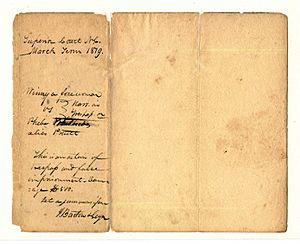Winny v. Whitesides facts for kids
Winny v. Whitesides alias Prewitt was a very important legal case heard by the Supreme Court of Missouri in 1824. It was the first time this court decided if an enslaved person had the right to be free. The court ruled that if an owner took an enslaved person to a place where slavery was not allowed, and lived there, that person would become free. This freedom stayed with them, even if they were later brought back to a place where slavery was allowed. This idea became known as "once free, always free."
For about 20 years, this "once free, always free" rule was used in many other cases where enslaved people tried to gain their freedom.
Contents
Winny's Fight for Freedom
Around 1794 or 1795, a woman named Phebe Whitesides and her husband lived in the Carolinas. They had an enslaved girl named Winny, who was about 12 years old. When the Whitesides family moved to Illinois, which was a free territory at the time, they took Winny with them. They lived in Illinois for three or four years, still keeping Winny as an enslaved person.
Later, the Whitesides moved again, this time to St. Louis, Missouri. They brought Winny with them, and she was still held in slavery.
Taking Her Case to Court
In 1818, Winny decided to go to court to gain her freedom from Mrs. Whitesides (Mr. Whitesides had passed away). Her case started in the Superior Court of Missouri Territory. When Missouri became a state, her case moved to the Circuit Court of St. Louis County.
The court believed that Winny had been held as an enslaved person in Missouri for about 20 years before she asked for her freedom. The old court records do not say why she waited so long to sue, or what made her decide to sue when she did.
Winny's legal claim against Phebe Whitesides was called "assault and battery." In this case, it meant that Whitesides was holding Winny against her will, which was seen as "unlawful imprisonment."
Mrs. Whitesides argued that she was not doing anything wrong because Winny was her enslaved person. She admitted to holding Winny, but said it was not unlawful because Winny was not free. Winny disagreed with this defense.
The Jury's Decision
A trial with a jury began in February 1822. Winny's main argument was that living in the Northwest Territory (Illinois) had made her a free person. Whitesides' lawyer asked the jury to be told that Winny's time in Illinois did not make her free.
However, the judge refused this request. Instead, he told the jury that if they believed the Whitesides family had lived in Illinois with the plan to make it their home, then they should decide in favor of Winny. The judge also said they should give Winny money for damages, just like they would for anyone else who had been wrongly held against their will.
The jury agreed with Winny. They decided she was free and awarded her $167.50 in damages.
Why This Case Was Important
At the end of 1824, the Missouri General Assembly passed a new law. This law created a clear way for enslaved people to sue for their freedom and offered them some protection during the process. The years between 1824 and 1844 are often called the "golden age" for freedom suits. During this time, many enslaved people won their freedom in court.
Winny v. Whitesides set the standard for how freedom cases were decided until the 1850s.
The "Once Free, Always Free" Rule
Because of this case, courts in Missouri and Kentucky often ruled in favor of enslaved people. Many successful cases came from St. Louis County. Between 1806 and 1865, almost 300 enslaved individuals in the City of St. Louis alone went to court to fight for their freedom.
Some other important cases included Merry v. Tiffin & Menard, LaGrange v. Chouteau, Theoteste alias Catiche v. Chouteau, Julia v. McKinney, Wilson v. Melvin, and Rachel v. Walker.
Later Changes to the Law
The "once free, always free" rule was later overturned by the Missouri Supreme Court in the case of Dred Scott v. Irene Emerson in 1852. This was followed by the famous U.S. Supreme Court decision in Dred Scott v. Sanford in 1857. After 1852, very few enslaved people were able to win their freedom through lawsuits.


